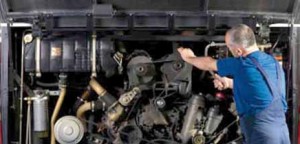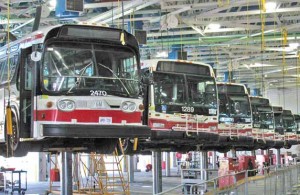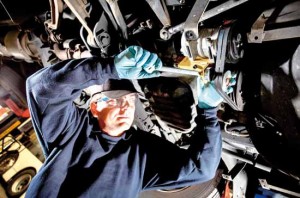By Atanu Maity, Climate Solutions, Ingersoll Rand India
 With the busy holiday season just around the corner, transit authorities and motor coach operators are dusting off their checklists and winterizing their fleets from the tyres up. This includes performing critical maintenance to keep bus heating, ventilating and air-conditioning (HVAC) systems performing at peak levels of efficiency and reliability.
With the busy holiday season just around the corner, transit authorities and motor coach operators are dusting off their checklists and winterizing their fleets from the tyres up. This includes performing critical maintenance to keep bus heating, ventilating and air-conditioning (HVAC) systems performing at peak levels of efficiency and reliability.
Keeping passengers safe and comfortable is a top priority for fleet operators everywhere. They know that nothing spoils a good ride like a bus that is too cold, too hot, too drafty or too stuffy because the HVAC system breaks down or does not work properly.
When it comes to HVAC system performance and reliability, there is no substitute for a proactive year-round maintenance strategy that focuses on preventing – rather than fixing – problems. Performing maintenance tasks at recommended intervals helps ensure that fleet operators stay on schedule, avoid breakdowns and service disruptions, manage operating costs and achieve higher levels of passenger satisfaction.
 Most public transportation authorities and motor coach companies perform HVAC preventive maintenance on the same schedule they use for the bus engine and chassis. It is also important to recognize that the unique operating characteristics of an HVAC unit need to be considered as part of an integrated service and maintenance strategy.
Most public transportation authorities and motor coach companies perform HVAC preventive maintenance on the same schedule they use for the bus engine and chassis. It is also important to recognize that the unique operating characteristics of an HVAC unit need to be considered as part of an integrated service and maintenance strategy.
An inspection and routine service schedule based solely on miles driven may not accurately reflect the wear and tear on the HVAC system because the unit runs whether or not the bus is in motion. In fact, the heating components in the HVAC system work continuously to maintain comfort levels when the engine is idling in traffic on a cold day or making scheduled stops to let passengers on and off, with the doors open. Not surprisingly, HVAC components like the blowers and water valves on buses operating in northern climates work particularly hard under these conditions.
 Thermo King, a global leader in transport refrigeration and a brand of Ingersoll Rand, recommends a blended approach to preventive maintenance, which establishes service intervals based on both mileage and operating hours. The company has developed a comprehensive schedule of inspections and routine service tasks:
Thermo King, a global leader in transport refrigeration and a brand of Ingersoll Rand, recommends a blended approach to preventive maintenance, which establishes service intervals based on both mileage and operating hours. The company has developed a comprehensive schedule of inspections and routine service tasks:
• 25,000 km – 30,000 km or within 45 days from installation
• 75,000 km – 80,000 km or within 135 days from installation
• 1,50,000 km – 1,55,000 km or within 270 days from installation
• 2,00,000 km – 2,05,000 km or within 365 days from installation
Need to consider local operating conditions
 This structured approach provides a solid platform for an effective preventive maintenance strategy. However, operators will also want to take their specific operating profile into account when developing an ideal schedule for their vehicles.
This structured approach provides a solid platform for an effective preventive maintenance strategy. However, operators will also want to take their specific operating profile into account when developing an ideal schedule for their vehicles.
For example, operators in colder climates may choose to inspect and test heating components more often during the winter months because the implications of a system failure are more serious. Those in areas with high levels of airborne particulates may want to change air filters more frequently.
The following are some specific steps that fleet operators should consider taking during their winter quarterly service interval:
• Inspect all air filters and wash or change if necessary
• Visually inspect the heating system for evidence of engine coolant leaks
• Conduct a running inspection and measure interior return air temperature, which should be maintained at 70 degrees or above
• In warmer climates, make sure that the air-conditioning system and fresh air ventilation components are working correctly
• Visually and audibly check HVAC blower motors and auxiliary heater blower motors (if they exist) for proper operation in the heat mode
• Check for proper thermostat function by using the air-conditioner to cool the bus interior down and then adjust the thermostat for the heating mode
• Check for proper operation of the driver’s heater and defroster unit.
Finally, the winter season and the beginning of a new year are ideal times for operators to examine their preventive maintenance approach and make sure that it continues to meet the needs of the organization. An effective, proactive and well-executed maintenance strategy pays for itself many times as compared to a bus’ typically long operating life by reducing operating costs, improving reliability and creating a better experience for passengers, drivers and maintenance teams.
Atanu Maity is Head – Business Operations for Climate Solutions India. He is responsible for ensuring fulfillment and aftermarket operations, productivity and utilization management, warranty and cost control, field quality and CRM. A seasoned professional with all-round experience in multiple industries in areas of Operations and Business development, he has been successfully steering Thermo King Business for the past couple of years.